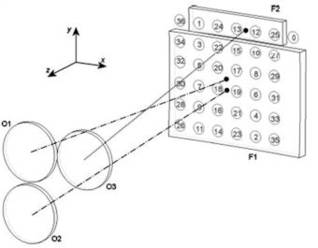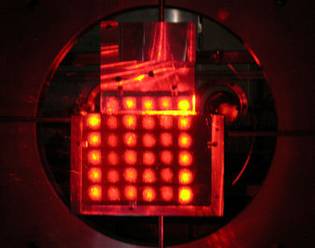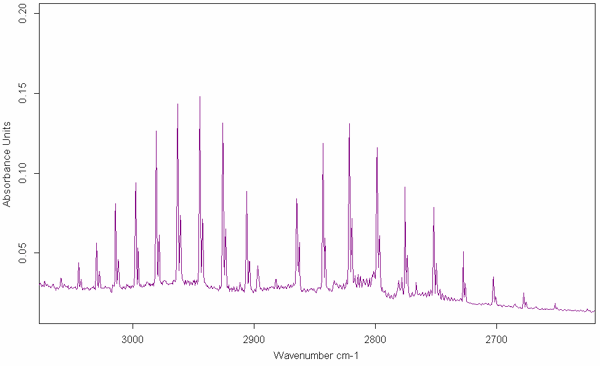FTIR
Fourier Transform Infra-Red Spectroscopy, FTIR, is an almost universal and highly selective detection method for many atmospherically relevant trace gases such as O3, CH4, HCHO and CH3CHO. It is therefore one of the most commonly employed detection systems in atmospheric simulation chambers.

Schematic of the 72 pass arrangement for the modified Chernin cell multipass optics in HIRAC.

Picture of the field Images in the modified Chernin cell multipass optics in HIRAC.
FTIR in HIRAC
An FTIR spectrometer (Bruker IFS/66) is coupled to a multipass optical arrangement mounted on the interior of the HIRAC chamber. The FTIR mirror system in HIRAC must be robust in order to withstand the range of temperatures (200 - 350 K) and pressures (10 - 1000 mbar) over which the chamber is designed to operate. Additionally the mirror system must be stable to sources of vibration from the chamber's pumping system and mixing fans. The multi-pass arrangement, shown in the schematic above, is a modified multipass matrix system (MMS) known as a Chernin cell featuring three objective mirrors that place the input and output aperture on opposite sides of the small field mirror (F2 in schematic). To our knowledge this design has not previously been implemented and offers several advantages over the traditional Bernstein-Herzberg (BH) modified White cell design including ease of alignment and good stability to vibrations and changes in the chamber pressure.
The mirrors are not directly mounted onto the end flanges of the chamber (even 25 mm thick stainless stell flanges will deform slightly under vacuum!), but are instead are fixed to crosses offset 10 mm from the internal face of the end of the chamber. All of the mirrors are made from zerodur, chosen due to its low thermal expansion coefficient, and have radii of curvature of 1785 ± 1 mm. The mirrors are coated with protected silver to give reflectivity >98% from the near infra-red to 16 microns. The maximum number of passes obtained through the system thus far is 124 with a 2.0 mm FTIR aperture. The optimised system has a base length of ~1.785 m and a total of 72 passes for an aperture of 2.5 mm. The detection limits (where S/N = 1) of several atmospherically relevant species have been determined using the optimised 72 pass system with a time resolution of 60 s (equivalent to a 12 scan average) both with and without the chamber mixing fans switched on. For ozone, acetaldehyde, methane and formaldehyde the limits of detection without the mixing fans were found to be ~20 ppbv, 35 ppbv, 30 ppbv and 20 ppbv respectively and these increased to ~60 ppbv, 80 ppbv, 75 ppbv and 50 ppbv respectively with the mixing fans switched on. Below is an example of a FTIR spectrum taken inside the HIRAC chamber.

Hydrogen Chloride spectrum taken using the FTIR instrument inside HIRAC.
